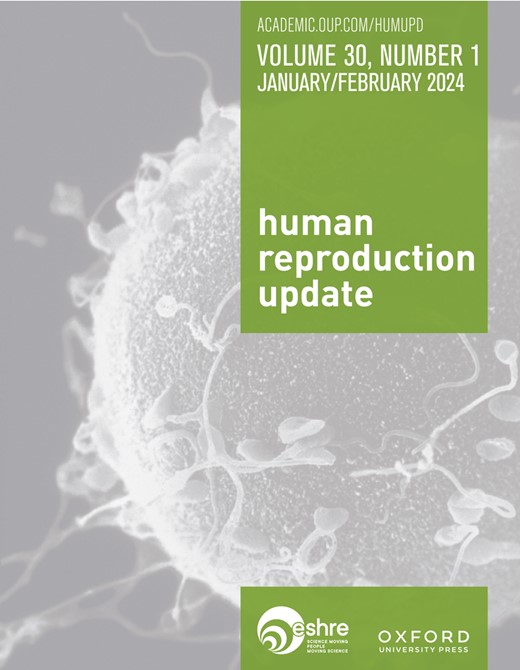精子头部形成及其在人类男性生育能力中的作用的分子见解
IF 16.1
1区 医学
Q1 OBSTETRICS & GYNECOLOGY
引用次数: 0
摘要
精子头部形成是由顶体-顶体-顶突复合体控制的,是精子发生过程中一个重要的形态变化,涉及许多以空间和时间特异性方式表达的蛋白质。精子头形缺陷常导致畸形精子症合并少精症和弱精症,但精子头形的致病机制及其在男性不育中的作用尚不清楚。目的与原理本文旨在总结精子头形形成的机制,揭示与精子头形形成相关的基因缺陷与人类和小鼠男性不育的关系,并探讨ICSI治疗的潜在临床改进。检索方法:我们在PubMed数据库中检索了以“精子头形”为关键词并结合以下术语发表的英文文章:“顶体形成”、“前顶体囊泡(paus)”、“manchette”、“核周膜(PT)”、“染色质凝聚”、“核骨架和细胞骨架连接物(LINC)复合物”、“组织-鱼精蛋白(HTP)转化”、“男性不育”、“ICSI”和“人工卵母细胞激活(AOA)”。对2024年8月1日之前的选定出版物进行批判性总结、整合和彻底讨论,排除不相关的文献。结果共检索到6823条记录。经过仔细筛选,整合相关文献,并排除与本综述主题无关的文章,240篇文章最终被纳入分析。首先,我们回顾了精子头部形成的重要分子事件和结构,包括PAV的形成到融合、顶体与细胞核的附着、manchette的结构和功能、PT、染色质凝聚和HTP的转变。然后,我们阐述了与精子头形相关的人类男性不育,并鉴定了导致畸形精子症合并少精症和弱精症的精子头形相关基因。最后,我们总结了由于与精子头形相关的基因突变导致男性不育的ICSI结果,以及通过AOA对精子头受损的不育男性进行ICSI的结果。了解精子头部形成的分子机制及其与人类男性不育的关系具有深远的临床意义,可能有助于人类男性不育的风险预测、遗传诊断和潜在治疗。本文章由计算机程序翻译,如有差异,请以英文原文为准。
Molecular insights into sperm head shaping and its role in human male fertility
BACKGROUND Sperm head shaping, controlled by the acrosome-acroplaxome-manchette complex, represents a significant morphological change during spermiogenesis and involves numerous proteins expressed in a spatially and temporally specific manner. Defects in sperm head shaping frequently lead to teratozoospermia concomitant with oligozoospermia and asthenozoospermia, but the pathogenic mechanism underlying sperm head shaping, and its role in male infertility, remain poorly understood. OBJECTIVE AND RATIONALE This review aims to summarize the mechanism underlying sperm head shaping, reveal the relationship between gene defects associated with sperm head shaping and male infertility in humans and mice, and explore potential clinical improvements in ICSI treatment. SEARCH METHODS We searched the PubMed database for articles published in English using the keyword ‘sperm head shaping’ in combination with the following terms: ‘acrosome formation’, ‘proacrosomal vesicles (PAVs)’, ‘manchette’, ‘perinuclear theca (PT)’, ‘chromatin condensation’, ‘linker of nucleoskeleton and cytoskeleton (LINC) complex’, ‘histone-to-protamine (HTP) transition’, ‘male infertility’, ‘ICSI’, and ‘artificial oocyte activation (AOA)’. The selected publications until 1 August 2024 were critically summarized, integrated, and thoroughly discussed, and the irrelevant literature were excluded. OUTCOMES A total of 6823 records were retrieved. After careful screening, integrating relevant literature, and excluding articles unrelated to the topic of this review, 240 articles were ultimately included in the analysis. Firstly, we reviewed the important molecular events and structures integral to sperm head shaping, including PAV formation to fusion, acrosome attachment to the nucleus, structure and function of the manchette, PT, chromatin condensation, and HTP transition. Then, we set forth human male infertility associated with sperm head shaping and identified genes related to sperm head shaping resulting in teratozoospermia concomitant with oligozoospermia and asthenozoospermia. Finally, we summarized the outcomes of ICSI in cases of male infertility resulting from mutations in the genes associated with sperm head shaping, as well as the ICSI outcomes through AOA for infertile men with impaired sperm head. WIDER IMPLICATIONS Understanding the molecular mechanisms of sperm head shaping and its relationship with human male infertility holds profound clinical implications, which may contribute to risk prediction, genetic diagnosis, and the potential treatment of human male infertility.
求助全文
通过发布文献求助,成功后即可免费获取论文全文。
去求助
来源期刊

Human Reproduction Update
医学-妇产科学
CiteScore
28.80
自引率
1.50%
发文量
38
期刊介绍:
Human Reproduction Update is the leading journal in its field, boasting a Journal Impact FactorTM of 13.3 and ranked first in Obstetrics & Gynecology and Reproductive Biology (Source: Journal Citation ReportsTM from Clarivate, 2023). It specializes in publishing comprehensive and systematic review articles covering various aspects of human reproductive physiology and medicine.
The journal prioritizes basic, transitional, and clinical topics related to reproduction, encompassing areas such as andrology, embryology, infertility, gynaecology, pregnancy, reproductive endocrinology, reproductive epidemiology, reproductive genetics, reproductive immunology, and reproductive oncology. Human Reproduction Update is published on behalf of the European Society of Human Reproduction and Embryology (ESHRE), maintaining the highest scientific and editorial standards.
 求助内容:
求助内容: 应助结果提醒方式:
应助结果提醒方式:


